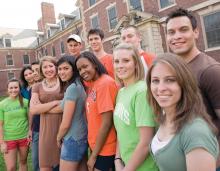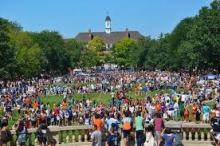College Towns Depend on Accurate Count of Students Living in Area

 A freshman living on campus in student housing. A junior varsity athlete sharing an off-campus house with teammates. A senior living solo in an off-campus apartment.
A freshman living on campus in student housing. A junior varsity athlete sharing an off-campus house with teammates. A senior living solo in an off-campus apartment.
Even though many residents of a typical American college town might move away after they graduate, they have to be counted while they live there.
College towns across the country depend on students’ responses to the census. The reason: Census results help determine how much federal funding communities will receive over the next 10 years.
A complete and accurate count in 2020 is so important that the U.S. Census Bureau is hiring an estimated 500,000 temporary employees to ensure everyone is counted.
“I have the recruiting staff go to the student unions at least once a week (if the schools allow them to) and set up a recruiting table,’’ said Marquette Youngblood, recruiting coordinator in the Dallas Regional Census Center.
Recruiters also go to other high-traffic areas “like the school gym to recruit students on campus while they are grabbing lunch or taking a break during the day to work out,” he said.
Students in college towns use critical local resources, including roads, public transportation and health clinics.
Getting funds for those resources, however, depends on making sure students are counted in the right place each census. And in most instances, if they’re not living at their parents’ home, chances are the right place is in the town where they attend school. Basically, a student’s “home” is where they currently live while attending college.
“Young college students may be going off on their own for the first time, and when they see a postcard or a census worker and are asked to take the census, they may not understand that they’re supposed to take it where they’re living,” said Evan Curtis, state planning coordinator and co-chair of the Utah Complete Count Committee. “They’re not just supposed to assume that their mom or dad will fill it in for them at home.”
The Utah committee is one of many such Complete Count Committees across the country working to educate their communities about the importance of responding to the 2020 Census—and how to accurately respond.
Where Is ‘Home’ for College Students?
When responding to the 2020 Census, college students should be counted where they live and sleep most of the time as of April 1, 2020.
For most students, that means in their college town, not back home with their parents.
Parents or guardians should only include children in college who live with them full time during the school year.
They should not list college students studying or living abroad on April 1.
It will be easier than ever for college students and other internet users to respond to the 2020 Census. For the first time, most people can respond online. They can also respond by phone or by mail, if they prefer.
Up to five invitations to respond to the 2020 Census will be mailed to all addresses beginning in mid-March. Residents of apartments or houses will receive information multiple times about the different ways to respond to the census.
Students Living in Private Off-Campus Housing
Students who live in off-campus housing that is not designed specifically for students – such as a rental apartment or house – need to respond to the census themselves. They should not count on their landlord to fill out a 2020 Census questionnaire.
Residents of every housing unit should work together to fill out one questionnaire per household. They should include all roommates (nonstudents, too) who live and sleep in the home most of the time.
The census will ask a few questions about each resident, such as age on Census Day (April 1, 2020), sex and date of birth.
Residents of Housing Designed for Students
Students who live in campus dormitories and residence halls, university-recognized sorority and fraternity houses, or off-campus housing designed specifically for students (such as a privately-owned apartment complex with individual student leases or a university-owned apartment complex for students and their families) will be counted as part of the 2020 Census Group Quarters Enumeration operation.
A representative of each group quarters will be given several choices for how to handle counting the students who are living there. They can:
- Have a census taker drop off paper questionnaires to a representative of the building. The representative will give each student a questionnaire and collect them after they are completed. Then, the census taker will return to pick them up from the representative.
- Have a representative of the building complete one form listing all students, compiled using data from administrative records. The representative has the option to complete a version of this form online using a secure portal, or to have a census taker pick up a paper version from them.
- Give a census taker permission to knock on doors and conduct one-on-one interviews with students. This is much less common.
“How students participate is largely dependent on the method chosen by the school’s contact person, which is the case for all group quarter facilities because of privacy and security concerns,” said Judy Belton, who is in charge of 2020 Census special enumerations at the Census Bureau.
The goal is to ensure that all students will be able to participate and be counted in the 2020 Census. The Utah Complete Count Committee is encouraging student associations across the state to form their own committees to help inform students about why and how they need to complete the 2020 Census.
College students looking to get involved in 2020 can also apply online for part-time census jobs, which pay from $20.50 an hour. These jobs are a great opportunity for students to earn extra income while completing their studies—and to help ensure their college town is counted in 2020.
“College students will come into these communities and certainly they’ll use the services, they’ll have an impact on that town,” Curtis said. “We want to make sure for planning purposes that we understand the makeup of our communities.”
